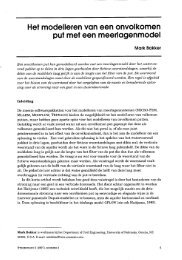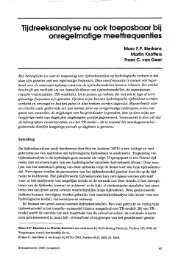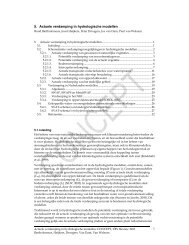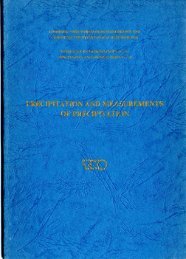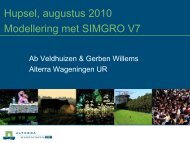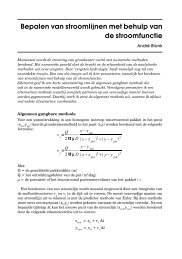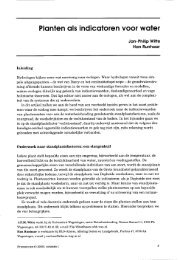Hydro-ecological relations in the Delta Waters
Hydro-ecological relations in the Delta Waters
Hydro-ecological relations in the Delta Waters
Create successful ePaper yourself
Turn your PDF publications into a flip-book with our unique Google optimized e-Paper software.
each of <strong>the</strong> birds' bill. Different age classes of bury<strong>in</strong>g bivalves.<br />
such ae! Scrobiacularia plmb andMacma balthica. can be successively<br />
eaten by different- species of waders depend<strong>in</strong>g on <strong>the</strong>ir bill ldngtb as<br />
<strong>the</strong> older <strong>in</strong>dividuals lie deeper <strong>in</strong> <strong>the</strong> substrate (Zmuts and wdnk.<br />
1984). Similarly dabbl<strong>in</strong>g ducks can reach aquatic plants only whit<strong>in</strong> a<br />
small depth range. Mute Waas can reach down to 1.5 meter, Cwts oaly<br />
to 0.5 meter. Bentbic feed<strong>in</strong>s ducks are also limited by <strong>the</strong> water depth<br />
as <strong>the</strong>y can stay rmdet- water only for a certa<strong>in</strong> time.<br />
However, <strong>the</strong> availability of <strong>the</strong> prey population can also he dependent<br />
on its own activity. Corophium volutator, a small crustacean Liv<strong>in</strong>g <strong>in</strong><br />
If-shaped burrows, is detected by its predators, e.g. Redshanks. when it<br />
is feed<strong>in</strong>g on <strong>the</strong> mudsurface by quickly mov<strong>in</strong>g <strong>the</strong> antennae. After a<br />
Bedshank passed, all C. volutator retreat <strong>in</strong> <strong>the</strong>ir burrow, due to <strong>the</strong><br />
vibrations <strong>in</strong> <strong>the</strong> sediment caused by tbe walk<strong>in</strong>g bird, aad become<br />
unavailable to <strong>the</strong> predators for nearly a quarter of an hour (Gsss-<br />
Custard, 1970).<br />
gno<strong>the</strong>r very important factor iufluenc<strong>in</strong>g bird distribution is<br />
sal<strong>in</strong>ity, not only by its effects un <strong>the</strong> prey populations, but by its<br />
<strong>in</strong>fluence on <strong>the</strong> osmoregulat1an of <strong>the</strong> predator. B i r h feeang on<br />
mar<strong>in</strong>e prey organisms have to excrete <strong>the</strong> excess amount of salt <strong>in</strong>take,<br />
while feed<strong>in</strong>g, throngh <strong>the</strong> dasal glands. If <strong>the</strong> sal<strong>in</strong>ity of <strong>the</strong> water<br />
where <strong>the</strong>p are feed<strong>in</strong>g is too hlgh, <strong>the</strong>y need to dr<strong>in</strong>k fresh mater <strong>in</strong><br />
order not to dehydrate (Nysrrtim and Pehrsson, 1988). It is very well<br />
documented that <strong>the</strong> Pochard, which feeds on Eelgrass (Zostera mar<strong>in</strong>a)<br />
<strong>in</strong> <strong>the</strong> sal<strong>in</strong>e Grevel<strong>in</strong>genmeer, rest on <strong>the</strong> fresh Har<strong>in</strong>guliet (Boudewijn<br />
and Mes, 1986). Nystriim and Pehrsson. 1988, l<strong>in</strong>ked both distribution<br />
and diet of swsrel coastal waterfowl species to <strong>the</strong>ir uptake and<br />
ability to excrete salt. It is most probably that <strong>the</strong> very high<br />
densities, especially of div<strong>in</strong>g ducks, <strong>in</strong> <strong>the</strong> Veerse Meer, <strong>in</strong><br />
oompirrison to <strong>the</strong> Grevel<strong>in</strong>gen Meer where <strong>the</strong> food supply i~ much<br />
higher, might be due to <strong>the</strong> much lower sal<strong>in</strong>ity <strong>in</strong> <strong>the</strong> Veerse Meer.





